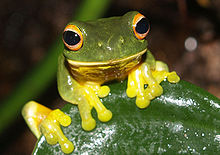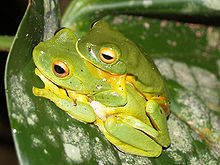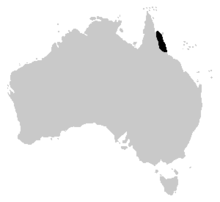- Orange-thighed Frog
-
Orange-thighed Frog 
Conservation status Scientific classification Kingdom: Animalia Phylum: Chordata Class: Amphibia Order: Anura Family: Hylidae Genus: Litoria Species: L. xanthomera Binomial name Litoria xanthomera
Davies, McDonald and Adams, 1986Distribution of the Orange-thighed Frog The Orange-thighed Frog (Litoria xanthomera) is a tree frog native to a small area of tropical northern Queensland, Australia. It is a green frog with distinctly orange eyes, and is very similar in appearance to the Red-eyed Tree Frog (Litoria chloris).
Physical description
 Tadpole of the Orange-thighed Frog
Tadpole of the Orange-thighed Frog
The Orange-thighed Frog is a medium-sized tree frog, reaching a length of 5.5 centimetres. It is a slender frog, with a thin body, flat head and large eyes, which are orange in colour. It has a green dorsal surface, with bright yellow feet, vocal sac and a yellow band down its flank. The inner surface of its legs are yellow, and the outer surface is green. It is distinguished, physically, from the Red-eyed Tree Frog by the presence of bright orange thighs, the Red-eyed Tree Frog has mavue thighes.
Ecology and behaviour
Male Orange-thighed Frogs congregate around still ponds, and call from low branches, or the edge of the water. The call is a long "aaa-rk", followed by a soft trill. They call after heavy monsoon rain. The males call in a large chorus; amplexus occurs where the frog calls, and the male and female move to the laying site. The eggs are brown, and are in masses of 800 to 1600. The tadpoles are identical in appearance to the Red-eyed Tree Frog.
The Orange-thighed Frog inhabits dense rainforest.
References
 Orange-thighed Frogs in amplexus.
Orange-thighed Frogs in amplexus.
- Barker, J.; Grigg, G.C. & Tyler, M.J. (1995). A Field Guide to Australian Frogs. Surrey Beatty & Sons. ISBN 0-949324-61-2.
- "Global Amphibian Assessment". http://www.globalamphibians.org/servlet/GAA?searchName=Litoria+xanthomera. Retrieved 2006-09-06.[dead link]
- Stratford, Danial (2000). "Litoria xanthomera". http://www.jcu.edu.au/school/tbiol/zoology/herp/Litoriaxanthomera.PDF. Retrieved 2006-09-06.
This Pelodryadinae article is a stub. You can help Wikipedia by expanding it.


